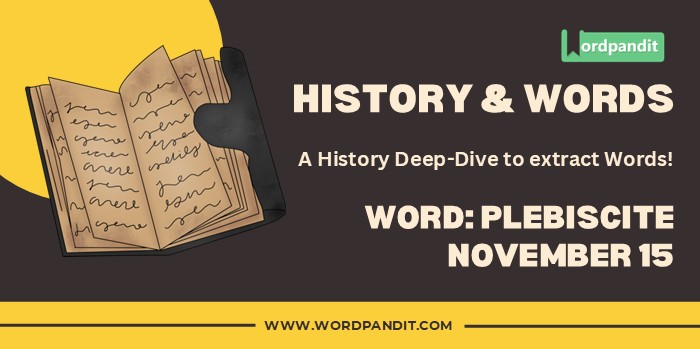History & Words: 'Plebiscite' (November 15)
Welcome to 'History & Words.' 🌟 I'm Prashant, founder of Wordpandit and the Learning Inc. Network. This series combines my passion for language learning with historical context. Each entry explores a word's significance on a specific date, enhancing vocabulary while deepening understanding of history. Join me in this journey of words through time.
📚 Table of Contents
🔍 Word of the Day: Plebiscite
Pronunciation: /ˈplɛbɪsɪt/ (PLEB-i-sit)
🌍 Introduction
On November 15, 1920, the League of Nations held its first assembly in Geneva, Switzerland, marking a pivotal moment in international relations. This new organization introduced several innovative diplomatic tools, among them the international plebiscite – a direct vote by the people to determine territorial sovereignty.
The concept of plebiscite represented a revolutionary approach to resolving territorial disputes, shifting power from monarchs and diplomats to the people themselves. This democratic tool would prove particularly significant in the aftermath of World War I, as Europe redrew its borders.
The League's use of plebiscites established a precedent for peaceful resolution of territorial conflicts that continues to influence international relations today.
🌱 Etymology
The word "plebiscite" derives from Latin "plebiscitum," combining "plebs" (common people) and "scitum" (decree). In ancient Rome, it originally referred to a law enacted by the "Concilium Plebis" (Assembly of the People), demonstrating its early democratic roots.
📖 Key Vocabulary
- 🔑 Referendum: A similar concept to plebiscite, often used for domestic matters
- 🔑 Sovereignty: The authority of a state to govern itself
- 🔑 Self-determination: The right of peoples to freely determine their political status
- 🔑 Mandate: The authority granted by a constituency to act on their behalf
- 🔑 Territorial Dispute: Disagreement between states over the control of geographic areas
🏛️ Historical Context
The concept of plebiscites existed before the League of Nations, with notable examples including the unification of Italy in the 1860s. However, the League systematized their use as a diplomatic tool.
The aftermath of World War I created numerous territorial disputes as empires collapsed and new nations emerged. The League of Nations saw plebiscites as a way to implement President Wilson's principle of self-determination while avoiding further conflicts.
The period between 1920 and 1935 saw several significant plebiscites organized by the League, including votes in Upper Silesia, Schleswig, and the Saar region.
⏳ Timeline
- 1918: End of World War I
- January 1919: Paris Peace Conference begins
- June 1919: Treaty of Versailles signed
- November 15, 1920: First League of Nations Assembly
- 1920-1921: Schleswig plebiscites
- 1921: Upper Silesia plebiscite
- 1935: Saar plebiscite
🌟 The Day's Significance
The first assembly of the League of Nations on November 15, 1920, institutionalized plebiscites as a tool of international diplomacy. This marked a significant shift from the traditional practice of great powers deciding territorial disputes without consulting local populations.
The League's embrace of plebiscites reflected a new understanding of international relations, one that emphasized popular sovereignty and self-determination. This approach would influence future territorial disputes and the development of international law.
The assembly established procedures for conducting fair and impartial plebiscites, including international supervision and peaceful implementation of results.
💬 Quote
"The people themselves must be the judges of their own destinies." - Woodrow Wilson, speaking about self-determination and the role of plebiscites
🔮 Modern Usage and Reflection
Today, plebiscites continue to play a role in international relations, though often under different names such as "referendum" or "popular consultation." Recent examples include South Sudan's independence vote in 2011 and various sovereignty referendums in Europe.
The concept has evolved to encompass broader questions of self-determination and democratic participation in major political decisions.
🏛️ Legacy
The League's plebiscite system, despite its mixed success, established important principles for resolving territorial disputes. These principles influenced the United Nations' approach to decolonization and self-determination.
Modern international law continues to recognize plebiscites as a legitimate means of resolving certain types of disputes, particularly those involving sovereignty and self-determination.
🔍 Comparative Analysis
While initially seen as a purely political tool, plebiscites have evolved to become part of a broader framework of democratic participation. Modern practice emphasizes not just the vote itself but also the conditions necessary for free and fair expression of popular will.
💡 Did You Know?
🎓 Conclusion
The introduction of international plebiscites through the League of Nations marked a significant step toward democratic resolution of territorial disputes. While not a perfect solution, it established important principles about self-determination and popular sovereignty that continue to influence international relations.
📚 Further Reading
- 📘 "The League of Nations and Self-Determination" by Thomas D. Grant
- 📗 "Plebiscites and Sovereignty" by Sarah Wambaugh
- 📙 "International Territorial Administration: How Trusteeship and the Civilizing Mission Never Went Away" by Ralph Wilde











